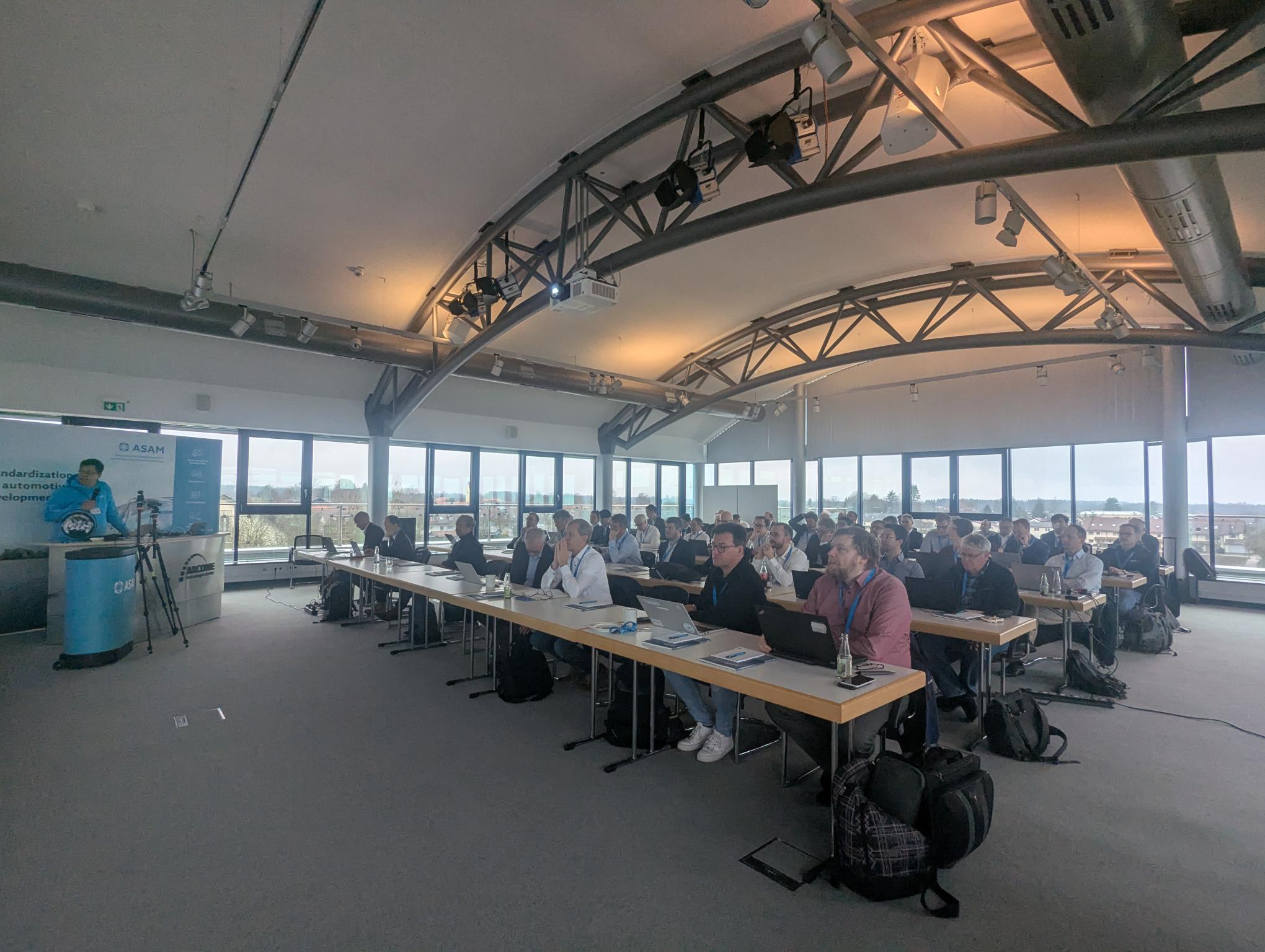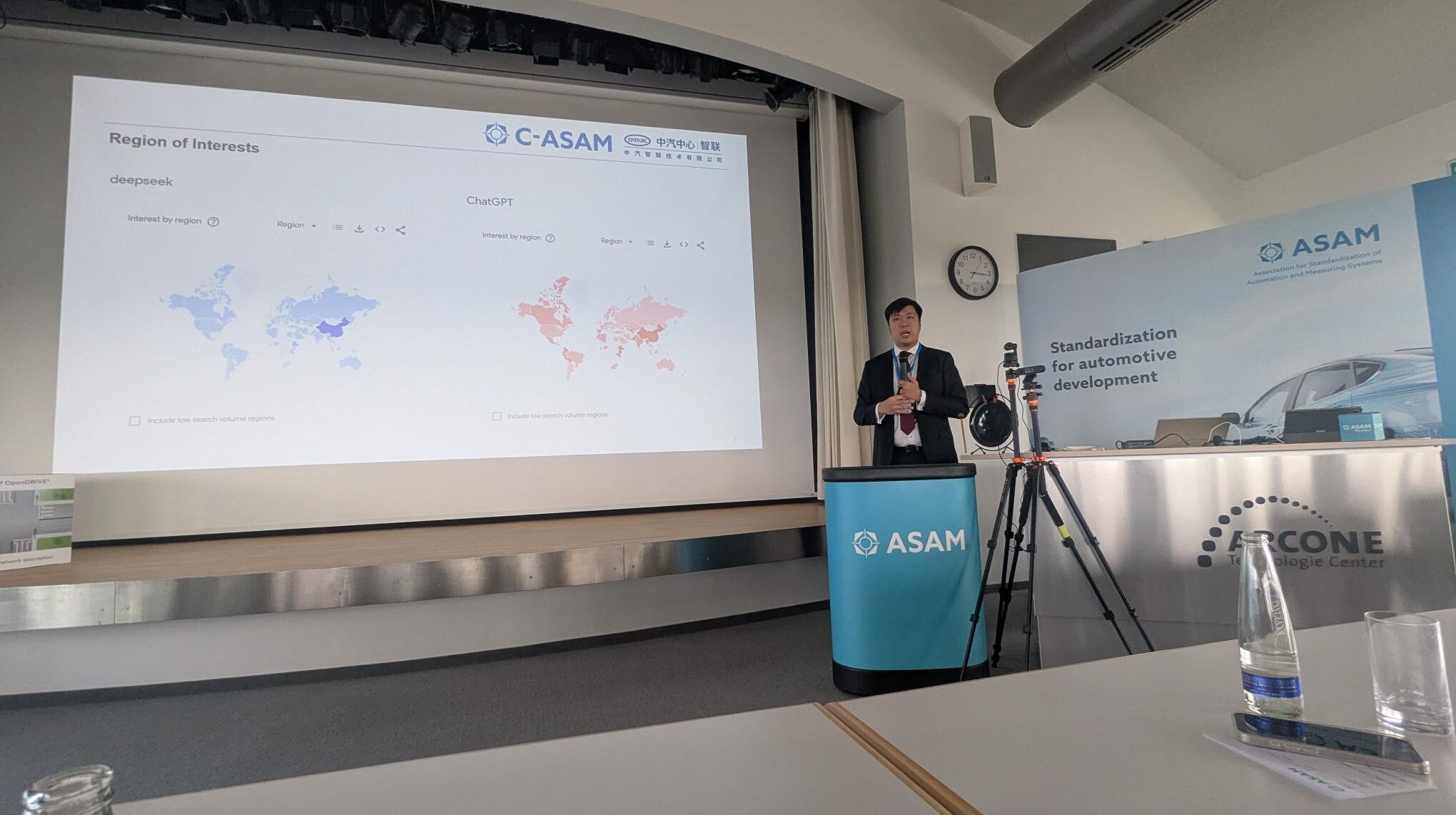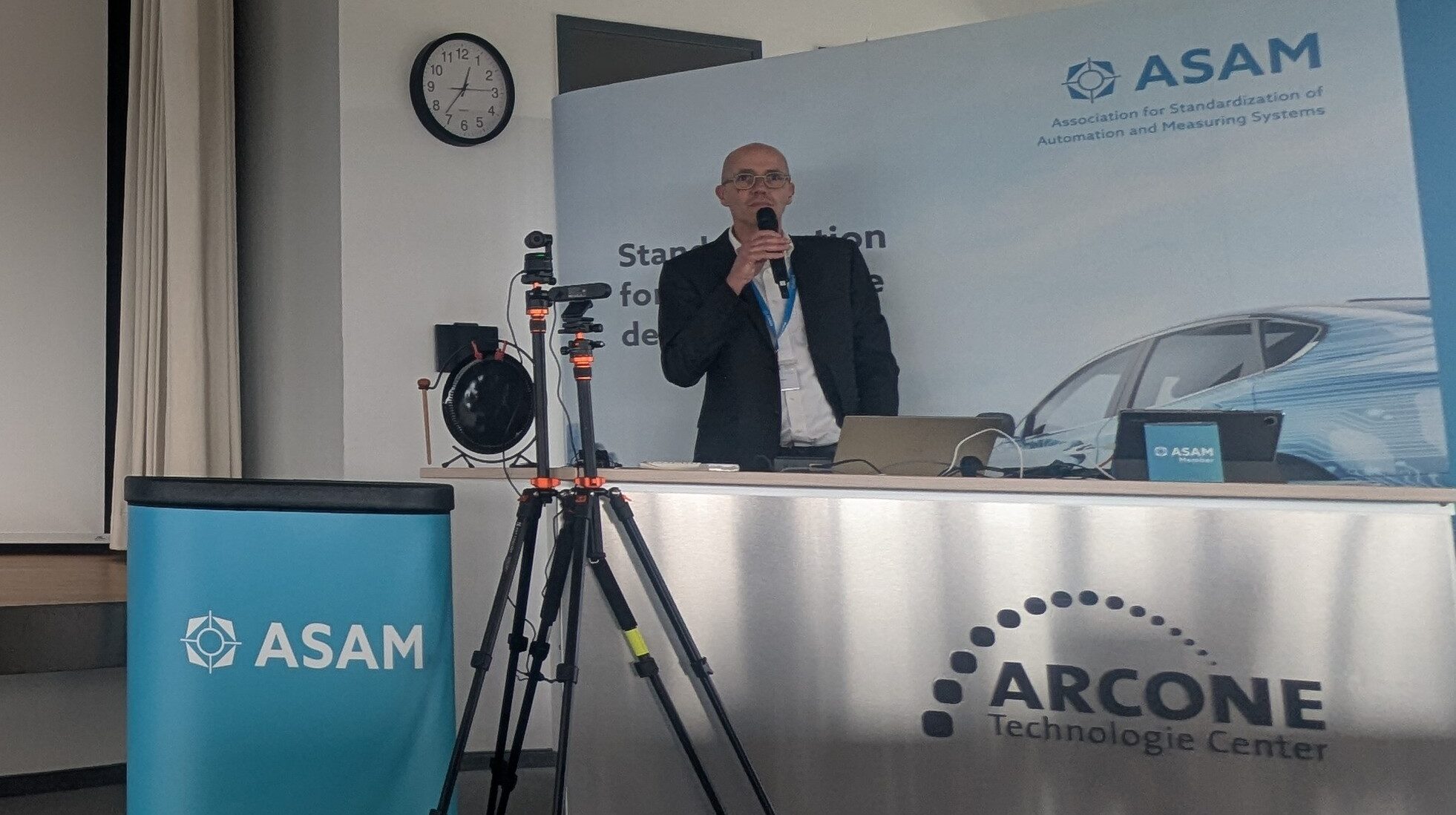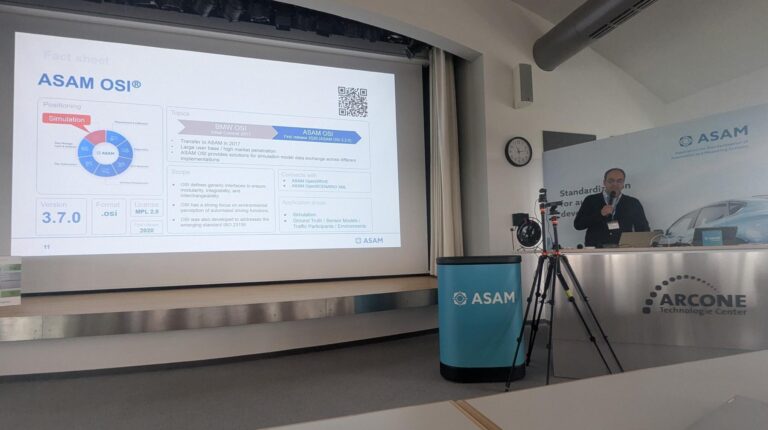Standardization organization ASAM held its annual Technical Seminar at its headquarters in Hoehenkirchen, near Munich, Germany, on April 1. The one-day seminar provided updates on the association’s key initiatives and positioning in the fields of SDV, AI and open-source as well as an opportunity for both members and non-members to discuss and contribute to ASAM standards.
The seminar took place during what is a challenging time for the automotive industry. Presenters assessed how standards can accelerate innovation and development, and how they can improve product quality and safety, and, importantly, customer value. Focusing on the implementation level of standards, the seminar placed a notable emphasis on trust in simulation, simulation quality and credibility, and the importance of collaboration via open-source projects.
The seminar opened with a welcome address by ASAM CEO Marius Dupuis, followed by ASAM Technical Steering Committee (TSC) spokesman Michael Schwarzbach, who gave a report from the ASAM Technical Steering Committee (TSC). Schwarzbach discussed the need to continuously work on standards and make them relevant for the market by identifying new requirements before release and ensuring they are firmly established in the member base, such as those surrounding driver monitoring systems and SOVD.
Process-related topics
Following the report, ASAM technology manager Yash Shah presented a proof-of-concept for agile standards development in the simulation domain, which would mean ASAM focuses more on feature-based projects decoupled from the releases to have shortened and more manageable timelines.
With the help of Change Control Boards (CCBs) for each standard and a coordination group, the TSC is responsible for approval of the projects, the budgets and the alignment of standards. Shah said, “If things go as hoped, then there will be a request to have an adoption of the new project process across further standards, taking lessons learned into account.” He cited the ongoing projects that require cross-standard alignment, such as labelling parking lots and garages as well as construction sites with permanent and temporary lanes in ASAM OpenDrive.
Dr Jochen Rauh, independent vehicle system dynamics consultant and expert and initiator of a “Curved-Regular-Grid” format (CRG), the predecessor of ASAM OpenCRG, which is used to provide data consistently and efficiently for simulation, combined with reference line information. Dr Rauh spoke about ASAM’s open-source project ASAM OpenCRG and a new journey into the future, taking experience and feedback from the past seven years under the ASAM roof into account. The project has been used in CAE simulation to analyze vehicle vibrations caused by wheels and tires and focuses on vehicle dynamics, ride comfort and durability, and ADAS/AD, among others.
 ASAM technology managers Shah and Ahmed Sadek then delved further into open source work at ASAM, including its current activities and future direction as well as examples ASAM OSI and ASAM OpenMaterial 3D. Sadek revealed there is an increasing need for open source to support standards and cited by way of example the hosting by ASAM of the second ASAM Quality Checker hackathon to identify areas for further development in assessing simulation data quality.
ASAM technology managers Shah and Ahmed Sadek then delved further into open source work at ASAM, including its current activities and future direction as well as examples ASAM OSI and ASAM OpenMaterial 3D. Sadek revealed there is an increasing need for open source to support standards and cited by way of example the hosting by ASAM of the second ASAM Quality Checker hackathon to identify areas for further development in assessing simulation data quality.
Alexander F Walser, managing director of the Automotive Solution Center for Simulation (ASCS), then explored the Quality Checker and its impact on marketplaces. “Simulation is all about data, you need a huge amount for a specific application,” he said. He also emphasized the automated testing of simulation model quality and fidelity, stating that multiple models from multiple sources must be combined for simulation-based testing, such as vehicle dynamics, perception sensors and Car2X GNSS.
He also addressed the challenge of securing quality in data spaces. For instance, when working with different partners, what are the rules and technical guidelines? He introduced DEMIM – a digital identity verification service, used to conduct quality checks and labels on a multitude of reference datasets. DEMIM’s data is not stored on the blockchain, which is variable, instead it is stored on a sensor model and can define new specifications in a growing/changing marketplace.
ASCS has recently developed the data-driven Envited-X Data Space for automated mobility systems, combining AI and simulation and HPCs to verify the correctness of data descriptions. The company’s vision is for virtual testing to be the main pillar for homologation and ensuring safety. Walser said, “It’s a strategic decision of the ASCS community that the data space is open-source because we talk in that framework a lot about trust and traceability, and it’s important for us that our members trust us, understand how the technology works, and that the data within such a data space is secure. We have a lot of requirements for data spaces, and the big question is how to secure quality accumulation data space.”
Markus Rettstatt, head of software-defined car at Mercedes-Benz Tech Innovation, was also in attendance at the Technical Seminar to propose how standardization can be accelerated with open source. Rettstatt oversees software strategy, and partners with Mercedes-Benz leadership to accelerate enterprise-scale software transformation, driving an overall strategy for software-defined vehicles in line with Mercedes CSO Magnus Ostberg’s vision to work with open-source communities, OEMs and tech partners to shape the future together. Drawing upon the challenges in today’s automotive industry and the battle for technological supremacy, Rettstatt argued that increasing the use of standards through collaboration lowers costs and accelerates innovation while increasing customer value. The solution he presented was a software architecture-driven development in open-source applications, for example ADAS, body and comfort, Eclipse S-Core connectivity and infotainment.
“Traditional standardization propositions are too slow for SDVs,” he said. “Ensuring compliance on day one would phase out our legacy constraints, iterate on software speed, be future proof and customer led.” He argued for the need for a hybrid path to sustainable standards, balancing speed and stability, and using an innovation paradigm of dynamic software development, structured standardization and governance compliance with ASAM standards to ensure the interoperability of systems and improved software quality, leading to faster, more robust development cycles. He suggested that a standards evolution could originate with the developers ‘code-first approach’ in order to adapt standards.
Simulation quality
A novel standardization initiative on Quantifying Simulation Quality (QSQ) between ASAM and Hochschule Duesseldorf – University of Applied Science (HSD) was presented by Prof. Dr Alexander Braun, who said they have been pursuing the need to quantify simulation quality for several years by looking at both sensor level simulation and whole simulation toolchains. He gave three metrics to evaluate simulation quality: model level, image quality level and applications level, with the goal for a lab-in-a-sim.
He was followed by Kosuke Yamazaki, senior standardization strategy expert at Song Semiconductor Solutions Corporation, who presented a solution to improve camera simulation quality that enabled users to validate algorithm/safety of ADAS functions. He proposed extensions to ASAM OSI that would make it easier to provide, for example, feedback from an ECU (simulation) to a render engine. ASAM will follow his proposals in an upcoming concept project, leading to an enhanced future version of ASAM OSI.
On the topic of ‘Application of standards’, Armin Happel, principal software development engineer at Vector Informatik, discussed V2X as sensors for ADAS. He said, “We need V2X – it should be interoperable and available as a standard for all vehicles, to improve sensor information in a map and to see beyond trucks in front by focusing on direct near-field communication. The goal is to avoid accidents and improve road safety. Its current status is awareness driving, but the main goal should be to share sensor information. V2X and ADAS go hand in hand.”
A talk from Gil Amid, chief regulatory affairs officer, VP operations and co-founder at Foretellix, and Simone Haemmerle, principal application engineer – ADAS/AD at MathWorks, revealed that solutions from multiple vendors have been proven to be interoperable using ASAM standards.
In their presentation ‘Accelerate engineering for mobility: interoperability between Foretellix/Foretify and Mathworks/RoadRunner via ASAM OpenScenario DSL’, they focused on the challenges in virtual validation and ADS, such as having enough scenarios and ensuring abstraction, seamless data exchange, and exposing system limitations on edge cases.
They used best-in-class as starting point as both were platform-independent; the Open-Scenario DSL tool (designed to express four levels of abstraction) was then used to explore scenario variations and give a full evaluation. Abstraction then identified scenario gaps and edge cases. Amid and Haemmerle explained that ASAM OpenScenario was a backbone for enhanced productivity and team collaboration.
 CATARC’s Bolin Zhou then gave an insight into ASAM standards in AI tools via a short exercise using ChatGPT and DeepSeek, which he said showed that AI is not (yet) properly trained. “It should be helping us rather than vice versa,” he said. “For instance, there are some ambiguities in the standards which it can help to identify.”
CATARC’s Bolin Zhou then gave an insight into ASAM standards in AI tools via a short exercise using ChatGPT and DeepSeek, which he said showed that AI is not (yet) properly trained. “It should be helping us rather than vice versa,” he said. “For instance, there are some ambiguities in the standards which it can help to identify.”
Breakout sessions moderated by Bolin, Ahmed and Yash followed, on ASAM standards in AI tools and ASAM OpenX PoC, an agile standards development approach.
The seminar closed with topics from partners, and included discussions on simulation credibility and future validation from Prof. Dr Reza Rezaei at the IAV.
 Summing up this year’s seminar, ASAM CEO Marius Dupuis said, “All the solutions, opportunities and ideas that were presented at the ASAM Technical Seminar focused on collaboration. ASAM standards offer a common language that enables all stakeholders to understand one another and communicate seamlessly.
Summing up this year’s seminar, ASAM CEO Marius Dupuis said, “All the solutions, opportunities and ideas that were presented at the ASAM Technical Seminar focused on collaboration. ASAM standards offer a common language that enables all stakeholders to understand one another and communicate seamlessly.
“Our global presence through local representatives and work groups demonstrates that engaging with ASAM helps to align standards, increase their impact, and elevate the quality and credibility of solutions worldwide.”
Find out more about enhancing automotive interoperability with standards from ASAM’s technology manager, Diego Sanchez, at ADAS & Autonomous Vehicle Technology Expo Europe 2025, (May 20, 21 & 22, at the Messe Stuttgart, Germany), where he will give a presentation titled ‘Enhancing automotive interoperability with standards: ASAM OpenMaterial and 3D Model’ on the first day of the conference.


